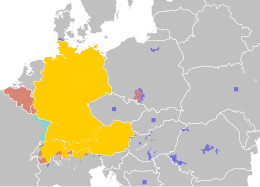Periodisation
The German term was originally coined in 1819 by Jacob Grimm for the period from around 1450 to the present day, following on from Middle High German (Mittelhochdeutsch). [2] [3] However, in 1878 Wilhelm Scherer proposed a transitional period, 1350–1650, for which he coined the new term Frühneuhochdeutsch (Early New High German), thus dating New High German from the mid 17th century. [4] In spite of many alternative proposals, [5] Scherer's remains the most widely adopted periodisation of German. [6]

There are both linguistic and extra-linguistic reasons for regarding the mid-17th century as the beginning of a new linguistic period. By this time, the sound changes which result in the phonological system of Modern German had been completed—no further major changes take place within the NHG period. [7] The Thirty Years War saw the population reduced by at least one third, and the subsequent Treaty of Westphalia, signed in 1648, guaranteed the relative independence of hundreds of small and large states within the Holy Roman Empire, as well as recognizing the complete independence of the Netherlands and Switzerland. [8] The 1641 publication of Justus Georg Schottelius's Teutsche Sprachkunst marks the beginning of the debate about a standardized national language. [9]
The New High German period is often subdivided, with a general consensus over a break in the first half of the 19th century, with another after 1945. [10] The earliest of these periods, Older New High German (Älteres Neuhochdeutsch), sees the gradual establishment of a standard written language by grammarians, lexicographers, and writers; the second, Younger New High German (Jüngeres Neuhochdeutsch), sees the spread of this standard throughout the publishing media (and becoming an international language of science), into the schoolroom, and into spoken German. [11] After 1945, the loss of German-speaking territory in the East, the decline of German as an international language, and the massive influence of English on the vocabulary are seen as markers of a new period, referred to as Gegenwartsdeutsch ("contemporary German"). [12] [13] These changes, however, are in the status and use of the language, while the phonology and morphology have seen only rationalisation and not substantial change over the last 370 years. [14] [7]
